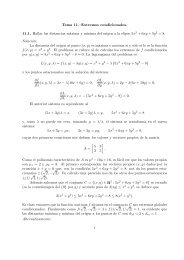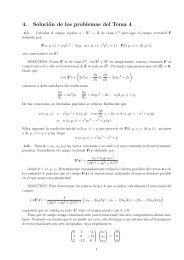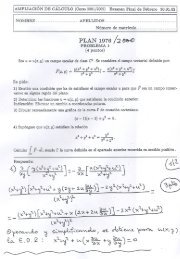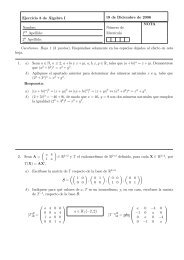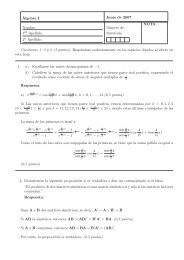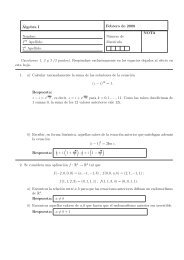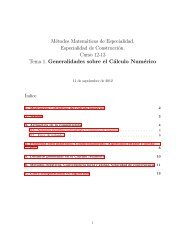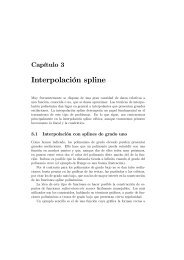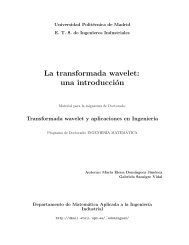La integral de Riemann - dmaii
La integral de Riemann - dmaii
La integral de Riemann - dmaii
Create successful ePaper yourself
Turn your PDF publications into a flip-book with our unique Google optimized e-Paper software.
142 Capítulo 6. <strong>La</strong> <strong>integral</strong> <strong>de</strong> <strong>Riemann</strong><br />
(si a < b el término <strong>de</strong> la <strong>de</strong>recha es b<br />
a | f |, como hasta ahora). En cuanto a la monotonía, notemos<br />
que si 0 ≤ f ≤ g son funciones integrables po<strong>de</strong>mos asegurar que<br />
ya que si a > b esta <strong>de</strong>sigualdad es a<br />
<br />
<br />
<br />
b<br />
a<br />
b f ≤ a<br />
b<br />
c<br />
cualquiera que sea el or<strong>de</strong>n entre a,b y c.<br />
a<br />
<br />
<br />
f ≤ <br />
b<br />
a<br />
<br />
<br />
g,<br />
g. Por último, si las <strong>integral</strong>es tienen sentido entonces<br />
f +<br />
b<br />
c<br />
b<br />
f = f<br />
a<br />
Teorema 6.3.4 (teorema fundamental <strong>de</strong>l cálculo <strong>integral</strong> (segundo)). Sea f una función integrable<br />
en [a,b]. Definamos F : [a,b] → R mediante<br />
Entonces:<br />
a) F es continua en [a,b];<br />
F(x) =<br />
b) si f es continua en algún x0 ∈ [a,b], entonces F es <strong>de</strong>rivable en x0 y<br />
x<br />
a<br />
f .<br />
F ′ (x0) = f (x0).<br />
Demostración. a) <strong>La</strong> función f es integrable, así que está acotada; sea K > 0 tal que | f (x)| ≤ K para<br />
todo x ∈ [a,b]. Veamos que para cada x,y ∈ [a,b], |F(x) − F(y)| ≤ K|x − y|.<br />
Si x = y, no hay nada que probar. Si no, po<strong>de</strong>mos suponer que x > y, por ejemplo. Entonces,<br />
<br />
<br />
|F(x) − F(y)| = <br />
<br />
x<br />
a<br />
y<br />
f (t)dt −<br />
a<br />
<br />
<br />
f (t)dt <br />
=<br />
<br />
<br />
<br />
<br />
x<br />
y<br />
<br />
<br />
f (t)dt <br />
≤<br />
x<br />
y<br />
| f (t)|dt ≤ K|x − y|,<br />
como queríamos probar. Ahora, dado ε > 0, tenemos: para cada x,y ∈ [a,b] con |x − y| < ε/K, se<br />
cumple que |F(x) − F(y)| < ε. Es <strong>de</strong>cir, la función F es continua en [a,b] (<strong>de</strong> hecho hemos probado<br />
que es uniformemente continua).<br />
b) Supongamos que f es continua en algún x0 ∈ [a,b]. Se trata <strong>de</strong> probar que<br />
F(x0 + h) − F(x0)<br />
lím<br />
= f (x0).<br />
h→0 h<br />
Tanto si h > 0 como si h < 0,<br />
x0+h x0<br />
x0+h<br />
F(x0 + h) − F(x0) = f (t)dt − f (t)dt = f (t)dt,<br />
a<br />
a<br />
x0<br />
luego<br />
F(x0 + h) − F(x0)<br />
h<br />
− f (x0) = 1<br />
x0+h<br />
h x0<br />
Entonces, <br />
F(x0 + h) − F(x0)<br />
h<br />
f (t)dt − 1<br />
x0+h<br />
h x0<br />
<br />
<br />
− f (x0) <br />
1 <br />
= <br />
|h| <br />
x0+h<br />
x0<br />
f (x0)dt = 1<br />
x0+h<br />
[ f (t) − f (x0)]dt.<br />
h x0<br />
<br />
<br />
[ f (t) − f (x0)]dt <br />
.



